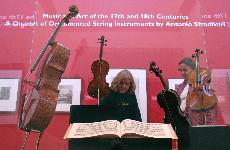Krannert gets prized artifact instruments

From left, Urbana resident Hilary Holbrook and her sister from California, Veronica Taylor, take a moment to look at the priceless set of instruments crafted by master builder Antonio Stradivari centuries ago that are on display at the Krannert Art Museum John Paul Goguen The Daily Illini
November 1, 2006
They are almost 400 years old, but they still have personalities, many consider them to be beautiful, and they refuse to be kept silent.
The four ornamented Stradivari instruments that have come to the University – two violins, a viola, and a cello – are nothing short of extraordinary, said Robert La France, associate curator of pre-modern art at the Krannert Art Museum.
“Antonio Stradivari produced over one thousand instruments, only about 650 of which survive,” said La France. “Of those, less than half are playable.”
The exhibition of the famed instruments is one of many planned events that Scott Schwartz, director of the University’s Sousa Archives and Center for American Music, hopes will help to raise the profile of American Music Month this November across the country.
Stradivari’s string instruments are prized for their beauty and craftsmanship in addition to their tonal quality. The quartet is the centerpiece of an exhibit at the Krannert Art Museum entitled “The Arts in Concert,” which features a number of paintings, books, prints, and pieces of music from Stradivari’s time in addition to his instruments.
Get The Daily Illini in your inbox!
Scott Schwartz was a key player in bringing the “Strads” to the University through partnership with the Smithsonian National Museum of American History.
“The University became a Smithsonian affiliate last August, and that helped us get the instruments here,” Schwartz said. “The affiliation allows us to share resources and knowledge.”
Gary Sturm, Smithsonian Museum curator in the division of music, sports and entertainment, said that the affiliation program and the exhibition of Stradivari’s instruments is part of the institute’s continuing mission to share national treasures with people all across America, not just in Washington, D.C.
“The idea was to take the Smithsonian and put it out there,” he said. “These instruments are particularly rare, because only 11 of the ones that Stradivari made throughout his lifetime are known to have special decorations applied to them.”
The two violins and viola have been ornately decorated, and a decal has been applied to the cello so that it matches the others in the quartet and appears similar to the only surviving ornamented cello, which is exhibited at the Royal Palace in Madrid. All four instruments bear names – the “Ole Bull Violin” (1687), the “Greffuhle Violin” (1709), the “Axelrod Viola” (1695) and the “Marylebone Cello” (1688) – and the four together are known as the “Axelrod Quartet of Ornamented Stradivari Instruments.”
“Each instrument has a distinct personality,” La France said. “Many are named after their most famous or important owners.”
Their trip to the University is significant because these particular instruments have never been to the Midwest before and have never been exhibited or played at a university, Schwartz said.
“These are rare artifacts,” he said. “But the art happens when the musician puts bow to string . they’re not just objects, they should be heard, too.”
But performances aren’t just for the entertainment of the concertgoers – they actually help to keep the instruments in playable condition.
“If you don’t play an instrument like this, eventually it dies,” La France said. “These are played about eight times a year by a very small set of people, most of them coming from Washington.”
La France said that there are several opportunities to hear the quartet played by Smithsonian professionals while they are in town. Free performances are scheduled for Nov. 12 and 14. Museum officials hope to draw in as many people as possible to experience the exhibit and related events before the artifacts depart for Washington in early December.
“The instruments provide a feast for the eyes and a feast for the ears,” Schwartz said. “There are lots of divides that are being crossed for American Music Month.”






